Agoston M.K. Computer Graphics and Geometric Modelling: Implementation and Algorithms
Подождите немного. Документ загружается.

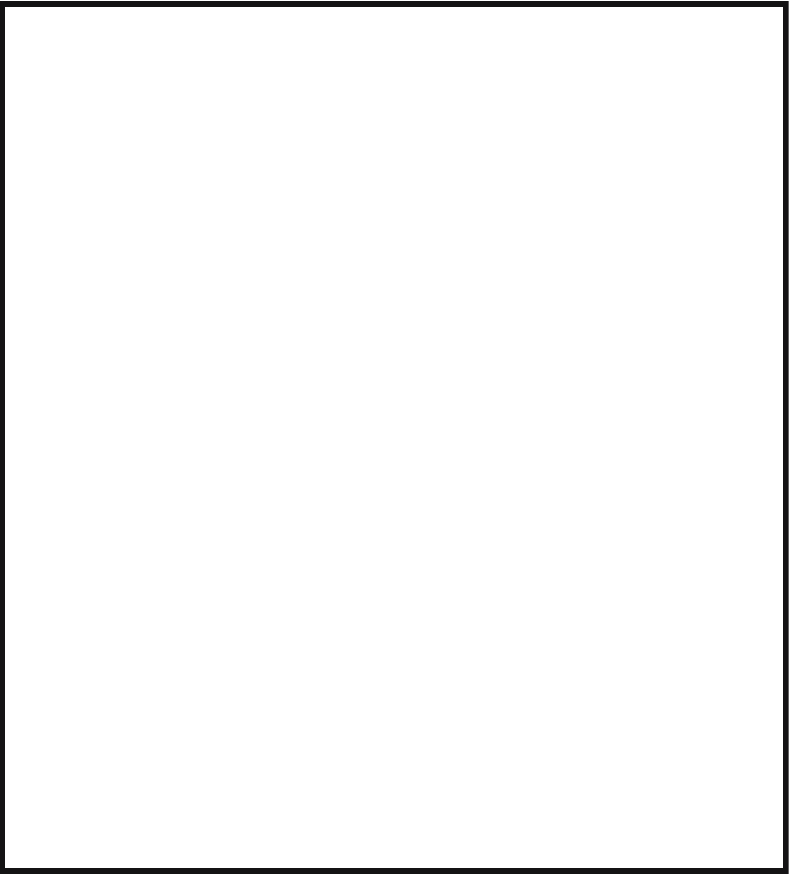
with angles close to p are often undesirable and a lot of work has been done to get
more nicely shaped triangles in the end. As one example, we mention the paper
[BeMR94] that describes a way to get a triangulation so that no angle in the triangles
is larger than p/2. It starts by first packing the polygon with disks.
Finally, the triangulation algorithm we described above also applies to polygons
with holes and, more generally, for arbitrary planar subdivisions. For polygons with
holes see also the trapezoidation algorithm in Section 14.4 and [ZalC99].
17.6 Triangulating Polygons 719
Inputs:
A strictly y-monotone polygon
P
specified by two chains of vertices
starting at the top vertex with one chain listing the vertices along the
right side of the polygon and the other listing the ones on the left
Outputs:
A triangulation of
P
as an appropriately specified list of edges T
tagged vertex p
i
,
p
;
stack of tagged vertices
S;
integer
i;
Order the vertices of
P
by decreasing y-coordinate with vertices having the same
y-coordinate being ordered by increasing x-coordinate. Let
p
1
,
p
2
,
º
,
p
k
be the
vertices listed in that order tagged by whether they are on the right or left side of
P
.
Initialize S to empty; Add all edges of
P
to T;
Push (
p
1
,S); Push (
p
2
,S);
for
i:=3
to
k
-
1
do
if p
i
and Top (S) lie on different sides of the polygon
then
begin
while
|S| > 1
do
begin
p
:= Pop (S); Insert a diagonal from
p
i
to
p
into T;
end
Pop (S); Push (
p
i
-
1
,S); Push (
p
i
,S);
end
else
begin
p
:= Pop (S);
while
diagonal from
p
i
to Top (S) lies in
Pdo
begin
p
:= Pop (S); Insert a diagonal from
p
i
to
p
into T;
end
;
Push (
p
i
,S);
end
;
Insert into T a diagonal from
p
k
to all the vertices on S except the first and last;
Algorithm 17.6.1. The triangulation algorithm for y-monotone polygons.
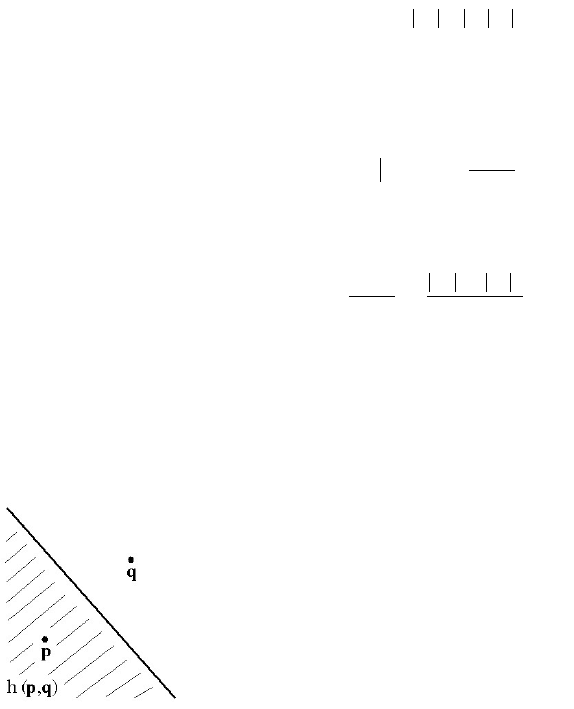
17.7 Voronoi Diagrams
Voronoi diagrams are structures that get used in many places in geometric modeling
and computational geometry. This section will define them and summarize some of
their more important properties. Some good references for more information about
them are [Aure91], [BKOS97], [PreS85], and [Edel87].
The general problem that Voronoi diagrams address is:
For each point p in a given a set S of points of a space X, find all the points of X that are
closest to p.
We make this more precise. We shall only consider Voronoi diagrams for the plane,
that is, the case X = R
2
. This is the case that one encounters most often. At the end
of the section we shall make some comments about other cases.
Definition. Let p, q ΠR
2
, p π q. Define the halfplane h(p,q) by
It is easy to show that h(p,q) actually is a halfplane. See Figure 17.13. In fact, it
is the halfplane containing p determined by the perpendicular bisector of the segment
[p,q], that is,
This fact follows easily from the identity
Now let S be a finite set of points in R
2
. The elements of S will be called sites.
Definition. The Voronoi cell of a point p in S, denoted by V(p), is defined by
Vhpp,q
qS p
()
=
()
Œ-
{}
.
I
pq r
p q pr rq
•.-
+
Ê
Ë
ˆ
¯
=
-
22
22
h p q r R pq r
pq
,•.
()
=Π-
+
Ê
Ë
ˆ
¯
£
Ï
Ì
Ó
¸
˝
˛
2
2
0
h p q r R pr rq,.
()
=Œ £
{}
2
720 17 Computational Geometry Topics
Figure 17.13. A halfplane h(p,q).
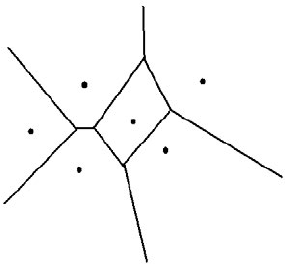
Figure 17.14 shows a Voronoi diagram for six sites. Here are a few basic facts
about the sets V(p):
17.7.1 Proposition. Let S be a finite set of n points in the plane.
(1) Each V(p) is a nonempty convex set because it is an intersection of (convex)
halfplanes that contain p. It has a nonempty interior because it contains a small neigh-
borhood about p consisting of points that belong to no other Voronoi cell.
(2) The boundary of each V(p) is the union of at most n - 1 segments or halflines,
called the edges of V(p). (We assume that an edge is a maximal linear subset of the
boundary, that is, the lines determined by the edges are distinct, or, alternatively, no
two edges lie in the intersection of the same pair of Voronoi cells.) The boundary has
at most n - 1 vertices, where a vertex is the intersection of two edges.
(3) Each point in the interior of an edge of a V(p) is equidistant to precisely two
sites. Each vertex is equidistant to at least three sites.
(4) If p π q, then V(p) « V(q) is either empty or consists of a single edge.
(5) Every point of the plane belongs to at least one Voronoi cell V(p).
Proof. Easy. See [Aure91] or [BKOS97].
Definition. The Voronoi diagram of the set S, denoted by Vor(S), is the set of Voronoi
cells V(p), p ΠS, together with their edges and vertices.
Proposition 17.7.1(4) and (5) imply that Vor(S) defines a kind of partition of the
plane. The only reason that we cannot call it a cell complex is that it contains
unbounded sets that are homeomorphic to half-open disks. (Cell complexes are defined
in Section 7.2.4 in [AgoM05]. Their cells must be homeomorphic to closed disks.)
Definition. Given a point p, let C
S
(p) denote the largest circle centered at p that con-
tains no site of S in its interior.
17.7.2 Proposition. Let S be a finite set of n points in the plane.
(1) Vor(S) contains precisely n “2-cells.”
(2) The Voronoi diagram contains no vertices if and only if all sites are collinear.
17.7 Voronoi Diagrams 721
Figure 17.14. A Voronoi diagram.
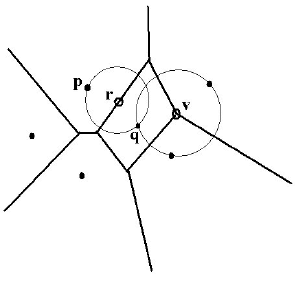
(3) A point v is a vertex of Vor(S) if and only if C
S
(v) passes through at least three
sites in S. See Figure 17.15.
(4) Two Voronoi cells V(p) and V(q) determine an edge of Vor(S) if and only if
there is a point r so that C
S
(r) contains p and q in its boundary but no other site. See
Figure 17.15.
(5) If no four points of S lie on a circle, then every vertex of Vor(S) belongs to
precisely three edges of Vor(S).
(6) Vor(S) contains at most 3n - 6 edges and at most 2n - 5 vertices.
Proof. See [BKOS97]. (3) and (4) characterize the vertices and edges of Vor(S).
Next, we consider the question of how to compute the Voronoi diagram for n sites
efficiently. Because the problem of sorting n numbers can be reduced to computing a
Voronoi diagram, one should not expect any algorithm to be faster than O(nlog n).
Fortune’s algorithm ([Fort87]) is an algorithm that achieves this best complexity.
17.7.3 Theorem. The Voronoi diagram of a set of n points in the plane can be
computed in time O(nlogn) using O(n) space.
Proof. See [BKOS97].
Voronoi diagrams can be generalized to higher dimensions. It has been shown
that Voronoi diagrams for n sites in R
m
can be computed in O(nlogn + n
Èm/2˘
) optimal
time. The important special case of Voronoi diagrams for three-dimensional linear
polyhedra has been studied extensively. A recent algorithm and implementation is
described in [EtzR99]. It separates the problem into two parts. First, a symbolic rep-
resentation called the Voronoi graph is computed and then the geometric part, namely,
the actual vertices and edges.
17.8 Delaunay Triangulations
Closely related to Voronoi diagrams are Delaunay triangulations. Again we shall
restrict ourselves to subsets of the plane.
722 17 Computational Geometry Topics
Figure 17.15. Characterizing vertices and edges of a
Voronoi diagram.
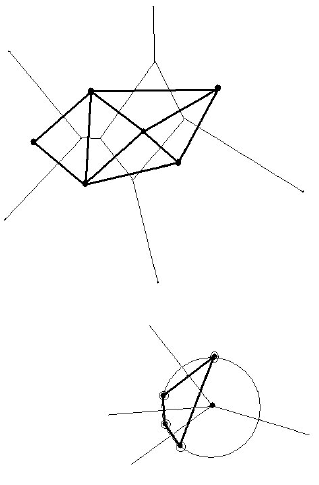
Definition. Let S be a finite set of points (sites) in the plane. The Delaunay graph
of S is the graph with vertex set S and whose edges are defined by the condition that
two vertices are connected by an edge if and only if the Voronoi cells associated
to those vertices share a common edge. The Delaunay cell complex of S is the two-
dimensional cell complex defined by the condition that its vertices and edges are the
vertices and edges of the Delaunay graph of S. The 2-cells are called the faces of the
Delaunay cell complex. By subdividing the faces of the Delaunay cell complex into tri-
angles, if they are not that already, one obtains a two-dimensional simplicial complex
called a Delaunay triangulation of S.
Figure 17.16 shows the Delaunay cell complex associated to the Voronoi diagram
in Figure 17.14. As we can see, it is in fact a Delaunay triangulation. Figure 17.17
shows a Delaunay cell complex defined by the four sites marked by circles. It consists
of a single face that is a quadrilateral and not a triangle. It admits two Delaunay
triangulations. Now, the fact that we always do get a real cell complex needs some
justification, which is provided by the properties of the Delaunay graph listed in the
following theorem.
17.8.1 Theorem. The Delaunay graph for a set S satisfies the following properties:
(1) The Delaunay graph G is the “dual graph” of the Voronoi diagram D in the
sense that a Voronoi cell in D becomes a vertex in G, an edge e in D defines an edge
in G between the two vertices in G that correspond to the Voronoi cells that have e
in common, and a vertex v in D defines the (triangular) region bounded by edges of
G which connect the Voronoi cells that have v in common. (Compare this to the
barycentric subdivision of a simplicial complex.)
17.8 Delaunay Triangulations 723
Figure 17.16. A Delaunay triangulation.
Figure 17.17. A nontriangular face of a Delaunay cell complex.
(2) An edge is orthogonal to the edge the Voronoi cells share but does not neces-
sarily intersect that edge.
(3) A Delaunay graph of a planar set is a planar graph.
(4) If no four points of S lie on a circle, then each face of the Delaunay cell
complex is a triangle.
(5) Three points of S are vertices of the same face of the Delaunay cell complex
if and only if the circle defined by them contains no point of S in its interior.
(6) Two points of S define an edge in the Delaunay graph if and only if there is a
closed disk that contains those points in its boundary and which contains no other
points of S.
(7) A Delaunay triangulation contains at most 3n - 6 edges and 2n - 4 faces.
Proof. See [Aure91] or [BKOS97]. Parts (5), (6), and (7) follow from Theorem
17.7.2(3), (4), and (6).
Definition. Let S be a finite set of points in R
2
. A triangulation of S is a simplicial
complex K whose vertex set is S and whose underlying space is the convex hull of S.
17.8.2 Theorem. Let S be a finite set of points in the plane and let K be a trian-
gulation of S. Then K is the Delaunay triangulation of S if and only if the circle cir-
cumscribing any triangle in K does not contain any point of S in its interior.
Proof. The theorem is an easy consequence of Theorem 17.8.1(5) and (6).
One of the important uses of Delaunay triangulations is to find a triangulation
of the convex hull of a set of points with the property that the triangles have as good
a shape as possible. For example, long thin triangles are undesirable in many
applications.
Definition. Let S be a finite set of points in the plane and let K be a triangulation
of S. If K has m triangles and if we order the 3m angles q
i
of these triangles in increas-
ing order so that q
i
£q
j
if i < j, then the vector (q
1
,q
2
,...,q
3m
) is called an angle vector
of K. The triangulation K is called angle-optimal for S if (q
1
,q
2
,...,q
3m
) ≥ (t
1
,t
2
,...,
t
3m
) for all angle vectors (t
1
,t
2
,...,t
3m
) of triangulations of S.
17.8.3 Theorem. Let S be a finite set of points in the plane.
(1) Any angle-optimal triangulation of S is a Delaunay triangulation of S.
(2) Any Delaunay triangulation of S maximizes the minimal angle of the trian-
gles in any triangulation of S. If no four points of S lie on a circle, then the Delaunay
triangulation of S is angle-optimal.
Proof. See [BKOS97].
The property in Theorem 17.8.3(2) can be expressed in another way. Note that
there are two ways that a quadrilateral can be triangulated because we can choose
either of the two diagonals. Given a triangulation, consider quadrilaterals that consist
of two adjacent triangles in that triangulation. A Delaunay triangulation has the
724 17 Computational Geometry Topics
property that, for all such quadrilaterals, the minimum of the six angles in the two
triangles that triangulate it will not increase if one switches to the other triangulation
and replaces the diagonal that is the common edge by the other diagonal. Although
Delaunay triangulations maximize the minimal angle of triangles, it is easy to give
examples that it does not minimize the maximal angle.
17.8.4 Theorem. Using a Voronoi diagram a Delaunay triangulation can be com-
puted in O(n) time after a precomputation time of the Voronoi diagram of O(nlog n).
Proof. See [Aure91] or [BKOS97].
Rather than computing a Delaunay triangulation from a Voronoi diagram, which
involves computing and storing the vertices of that diagram, there are algorithms that
compute it directly. The three main approaches are divide-and-conquer ([GuiS85] and
[Dwye87]), sweepline ([Fort87]), and incremental ([GreS77], [ClaS89], [BDST92],
[FanP93], [BoiT93], [Lisc94], [BKOS97], [Devi98]). According to tests described in
[SuDr95] and [Shew96] the divide-and-conquer algorithms seem to be the fastest with
the sweepline algorithms the next fastest and the incremental algorithms the slowest,
although the simplest. An algorithm based on the divide-and-conquer approach that
also extends to higher dimensions can be found in [CiMS98].
Finally, if one wants to generalize to higher dimensions, one can build on what is
known for Voronoi diagrams in that case or again try to deal with the problem directly.
For a survey of this topic see [Aure91]. A specific implementation for a Delaunay tri-
angulation for three dimensions can be found in [FanP95].
17.8 Delaunay Triangulations 725
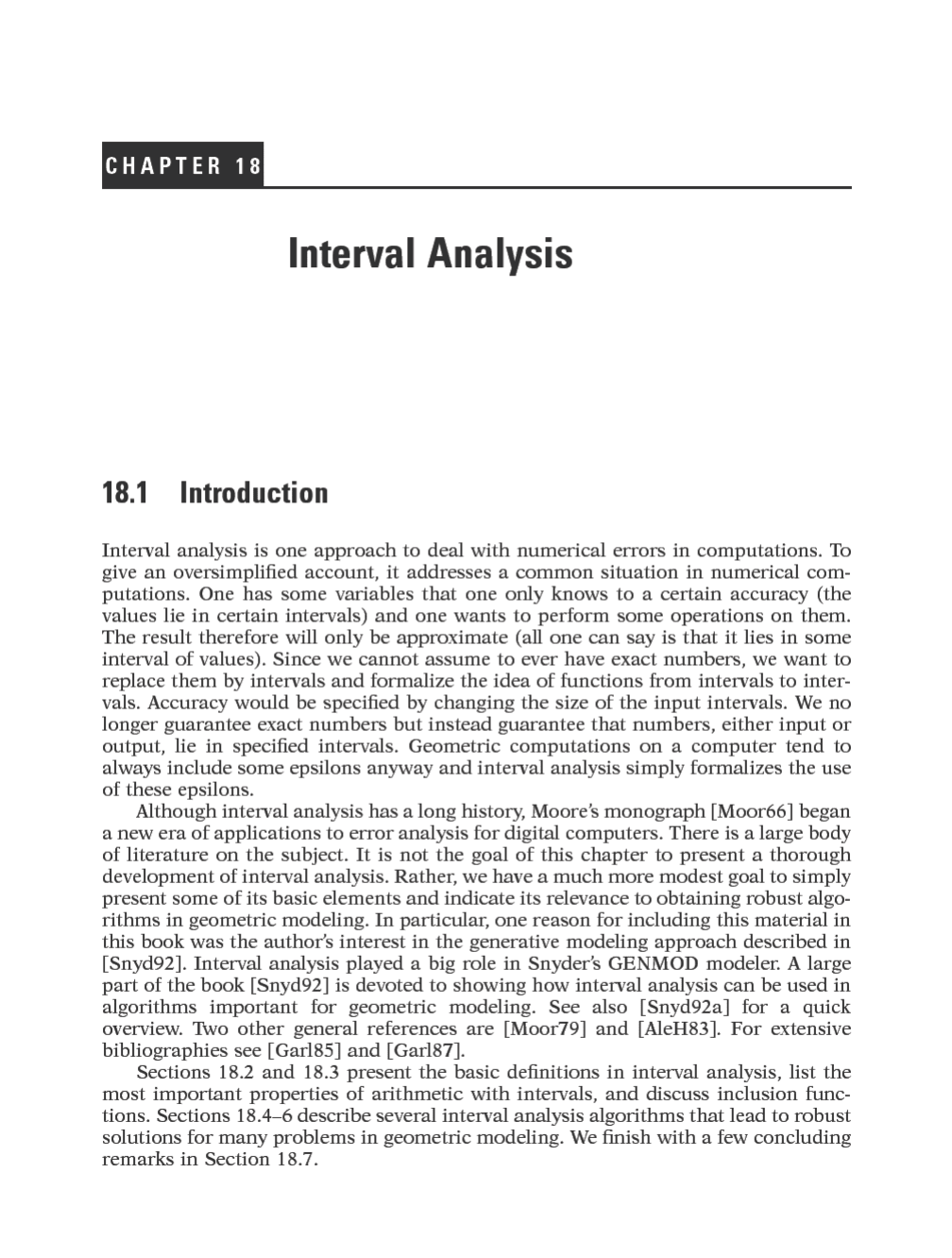

18.2 Basic Definitions
Definition. Let I(R) denote the set of closed intervals in R.
By identifying the real number a with the interval [a,a] we shall consider R
as a subset of I(R). Throughout this chapter we shall use capital letters to denote
intervals.
Definition. If A = [a,b] ΠI(R), then define
Next, here are the basic arithmetic operators of addition, subtraction, multipli-
cation, and division on intervals.
Definition. Let
*
Œ {+, -, ◊, /}. Let A, B Œ I(R). Define
In the case of /, we shall always assume that 0 does not belong to B. At times we shall
abbreviate the product A◊B to AB.
18.2.1 Lemma. If A = [a,b] and B = [c,d], then the following holds:
(1) A + B = [a + c,b + d]
(2) A◊B = [min(ac,ad,bc,bd), max(ac,ad,bc,bd)]
(3) A - B = [a - d,b - c] = A + [-1,-1]◊B
(4) A / B = [min(a/c,a/d,b/c,b/d), max(a/c,a/d,b/c,b/d)]
= [a,b]◊[1/d,1/c]
Proof. This is an easy exercise.
18.2.2 Examples. [-1,3] + [2,5] = [1,8]
[-1,3] - [2,5] = [-6,1]
[-1,3]◊[2,5] = [-5,15]
[-1,3] / [2,5] = [-1/2,3/2]
The next lemma summarizes some basic facts that, among other things, show that
the operations on I(R) act very much like they do on the reals R. The main fact that
keeps (I(R), +, ◊) from being a ring is that is does not have additive inverses.
18.2.3 Lemma. Let A, B, C, D ΠI(R). Then
(1) (Commutativity) A + B = B + A and A◊B = B◊A.
(2) (Associativity) (A + B) + C = A + (B + C) and (A◊B)◊C = A◊(B ◊C).
(3) (Identity) The intervals [0,0] and [1,1] are the unique additive and multi-
plicative identities, respectively. More precisely,
A B a b a A and b B
**
=Œ Œ
{}
lb A a and ub A b
()
=
()
=,.
18.2 Basic Definitions 727

728 18 Interval Analysis
(4) I(R) has no zero divisors.
(5) The only elements [a,b] in I(R) that have an additive or multiplicative inverse
are those for which a = b. However, we do have
(6) A◊(B + C) + A◊B + A◊C (subdistributivity)
a◊(B + C) = a◊B + a◊C, a Œ R
A◊(B + C) = A◊B + A◊C if bc ≥ 0 for all b Œ B and c Œ C
(7) If A Õ C and B Õ D, then A
*
B Õ C
*
D, for
*
Œ {+, -, ◊, /}. This is often expressed
by saying that the standard interval arithmetic operators are inclusion isotone or inclu-
sion monotonic.
Proof. This is fairly straightforward. See [AleH83].
18.2.4 Example. The distributive law fails:
Property (7) in Lemma 18.2.3 is particularly important. In the context of compu-
tations, it tells us that as new errors creep into computations we can keep control of
them.
It is possible to define a metric on I(R).
Definition. Define
by
18.2.5 Lemma. The function d defines a metric on I(R).
Proof. This is easy to show directly, but actually it is the well-known Hausdorff
metric.
18.2.6 Example. d([-1,3],[2,5]) = max(|-1 - 2|,|3 - 5|) = 3.
18.2.7 Theorem.
(1) (I(R), d) is a complete metric space.
(2) The operations of addition, subtraction, multiplication, and division defined
on I(R) are continuous.
dab cd a c b d, , , max , .
[][]
()
=--
()
dI I: RRR
()
¥
()
Æ
12 11 1 1 00 12 11 12 1 1 11,, , , ,,, , ,.
[]
◊
()
+- -
()
[]
=
[] []
◊
[]
+
[]
◊- -
[]
=-
[]
but
01Œ- Œ Œ
()
A A and A A Ifor all A R .
AXAAX
AYAAY
=+=+
()
=
[]
=◊=◊
()
=
[]
for all X in I if and only if X
for all Y in I if and only if Y
R
R
00
11
,.
,.
